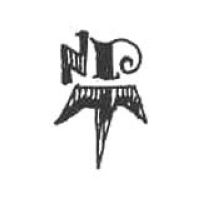
Image 010247-01-01
Used between 1919 and 1937.
The facility was founded in 1904 by a group of salesmen from in and around Tettau, who had up until then been re-selling items produced by the Königlich privilegierte Porzellanmanufaktur Tettau, which was also located in Tettau. Please note that the company form chosen, an e.GmbH, differs from the similar and more common form, the GmbH
Based on his experience in running similar companies, the partners voted for Hans Pülz to become first manager of the facility. Under his management, the facility soon exceeded the expectations by far and in 1913 already employed 125 people. The company specialized on producing figurines (including a high amount of lace figurines) as well as animal figure groups, but always produced a wide array of other items like lamp bases, vases, ashtrays, etc. Through various contacts based on the trade partners of the founders, the company also quite early produced items for export to the US and England.
In 1923, the company also included industrial porcelain items in its product portfolio and after a long period of internally restructuring the business, it was finally made into a (stock) corporation. With the changed product range, the company was able to serve a wider range of customers and did not have to depend on a single market alone. A few minor expansions followed, followed by a steady increase of employees up to a staff of 160 people in 1930.
One of the most important members of the board at this time was Karl Preissler, who greatly influenced the product range together with Fritz Gerold. Together, they were responsible for the improvements and investments made to ensure the future of the facility. This point of view was not always shared by the other shareholders and more than once, talks about planned investments ended in constant discussions on the board where Preissler and Gerold had to defend their ideas of a modern facility over and over again.
All this tired Karl Preissler who had not been at good health for quite some time. Together with Gerold he therefore had made plans to ensure that their ideas were not endangered if he should pass away: with the help of a handful of investors who wanted to see them lead the company, Preissler and Gerold slowly undermined the positions of the other shareholders, building up more and more leverage for a takeover. The pressure on Preissler was enormous and in 1937 his by then best friend Gerold saw that he would not be able to take much more.
Even if the proceedings had not advanced to a point where they could achive a total victory Gerold convinced the investors that they needed to take over immediately to save their investments as it was clear that during and after the war (which was already visible at the historical horizon) the conservative way of leading the company would lead to certain disaster.
Regrouping the shares that had been silently taken over by the various investors, Preissler and Gerold within a week held the majority in shares in their own hands. As most board members had been dealing with their shares, they now learned that conservative business methods had their drawbacks as Gerold handed them their resignations one by one.
Due to the incomplete measures taken before the takeover it still took a full two years until 1939 before Gerold was finally able to lever the remaining two shareholding companies out of the business. For Gerold, this was more than a normal business proceeding as he had kept the promise he had made to Karl Preissler shortly before he passed away.
At the time Gerold took over the company it had a workforce of 165 people. This number remained constant for the next years as the improvements to the production facilities required more or less the same number of workers even if output increased. During the period after the takeover, the company steadily increased its export trading and even produced unmarked pieces for certein customers. A fine example is a mold and pattern which was sold as Blue Pageant, a special unmarked export series produced before 1960. One distributor was Clarkson Table Appointments in Canada, and it can only be traced back to the Gerold & Co. by comparing mold types and the knowledge that the trademark "Porzellam" included was used by the Gerold company.
It should be mentioned that over the time Gerold Porzellan produced well over 12,000 products of which over 80 percent were for household use. But unlike other manufacturers who had such a tendency, Gerold also employed some of the best artisans in Europe, including many from the famous facilities in Nymphenburg and Meissen. The different styles were forged together into some beautiful series, for instance the lovely figures with the coloring of Lladro and the whimsical look of Hummel's, all colorfully hand-painted and finished as glazed or biscuit porcelain. But years after Gerold died, the facility ran into more and more problems and was finally forced to file for bankruptcy.
A few investors together with the local bank were determined to keep the factory alive and so a newly founded business under managing director Dieter Weller took over. But the new venue ran right into the same problems as the German porcelain market slowly crumbled away and was taken over by the famous big companies, forceing the new owners to sell again in 1997.
It should be mentioned that the company name was finally erased from the trade register during the first quarter of 2004, as can be seen from the corresponding trade register entries. This did not affect further proceedings, though.
The trademarks and many of the molds were bought by the Lindner Porzellanfabrik KG, a company with focus on decorational items located in the Upper Franconian town of Küps. Seeing that Gerold was orientated towards figural porcelain and items for kitchen and bathroom the two product ranges matched perfectly. A handful of former Gerold employees were relocated to Küps and the Lindner subsidiary was named Gerold Kueps, producing mainly new models and molds. As was confirmed by the Gossel family in November 2023 they are still active, with the Lindner Porzellanfabrik KG being one of the last remaining active porcelain factories in Germany.
Gerold marked items are sometimes found with an additional five-prong crown above "Dresden" (with quotes). This mark appears to be a Gerold original as the same mark was also found on undecorated whiteware, speaking against it being a decoration studio addition. As to why they used the term Dresden, a city known for decoration work, is well beyond me. Direct comparison between otherwise unmarked items with this crown mark and those which bear a Gerold mark only seem to confirm this as both items are otherwise identical.

Image 010247-01-01
Used between 1919 and 1937.
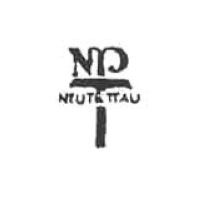
Image 010247-01-02
Used between 1920 and 1937, registered at the RWZR under №·245·792 on April 20th 1920.
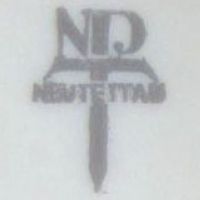
Image 010247-01-03
Used between 1920 and 1937, some (like this one) had a pointed vertical 'T' bar. Another version was used between 1946 and 1949 including 'US Zone'.
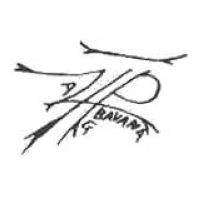
Image 010247-02-01
Used between 1928 and 1937, registered at the RWZR under №·383·982 on March 27th 1928.
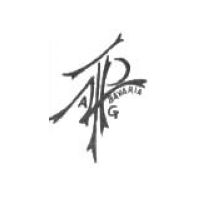
Image 010247-02-02
Used between 1928 and 1937, here a slighly more compact version.
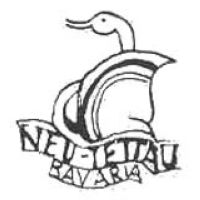
Image 010247-02-03
Used between 1929 and 1937, registered at the RWZR under №·406·498 on October 8th 1929.
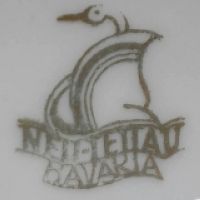
Image 010247-02-04
Used between 1929 and 1937, underglaze.
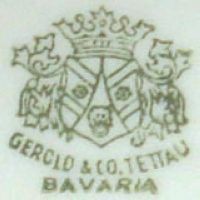
Image 010247-03-01
Used between 1937 and 1960, dark green version with "Gerold & Co. Tettau" over "Bavaria".
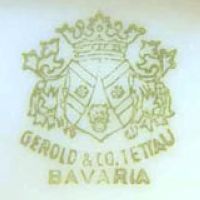
Image 010247-03-02
Used between 1937 and 1960, light green version with "Gerold & Co. Tettau" over "Bavaria".
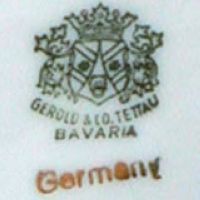
Image 010247-03-03
Used between 1937 and 1960, dark green version with "Gerold & Co. Tettau" over "Bavaria", additionally stamped "Germany" in gold.
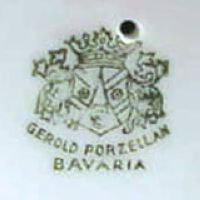
Image 010247-04-01
No date known, first "Gerold Porzellan" mark, only "Bavaria" without any other country addition.
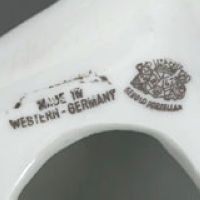
Image 010247-04-02
No date known, "Gerold Porzellan" mark with "Bavaria", with "Made in Western Germany" addition.
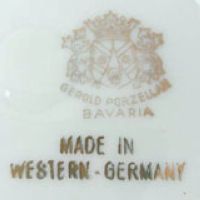
Image 010247-04-03
No date known, "Gerold Porzellan" mark with "Bavaria", with "Made in Western Germany" addition.
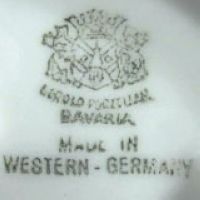
Image 010247-04-04
No date known, note the "Made in Western-Germany" with hyphen, first complete stamp.
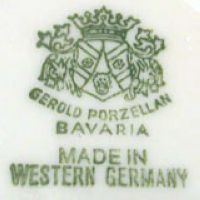
Image 010247-04-05
No date known, note the "Made in Western Germany" here without hyphen, which is the later version.
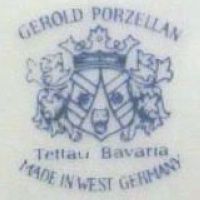
Image 010247-04-06
No date known, note the "Made in West Germany".
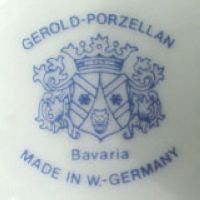
Image 010247-04-07
No date known, one of the last marks used, note the "Made in W.-Germany".
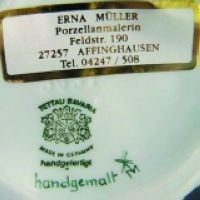
Image 010247-04-08
No date known, item decorated around 1993 by Erna Müller from the town of Affinghausen in Lower Saxony.
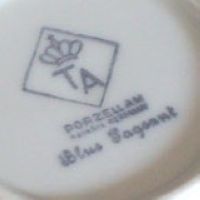
Image 010247-00-01
No date known, Gerold "TA" brand mark, here on the "Blue Pageant" series.
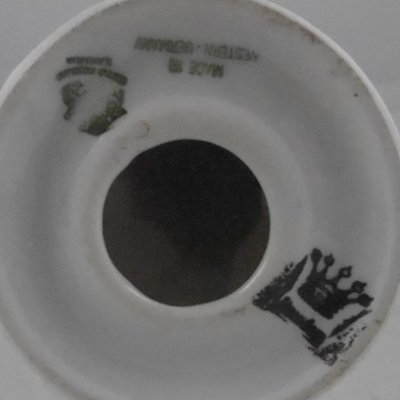
Image 010247-00-02
No date known, Made in Western-Germany mark plus crowned "Dresden" additional mark.
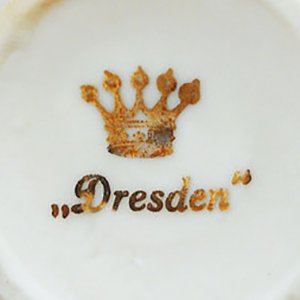
Image 010247-00-03
No date known, crowned "Dresden" mark found on otherwise unmarked Gerold items.
© 2004-2025 C.S.Marshall, all rights reserved